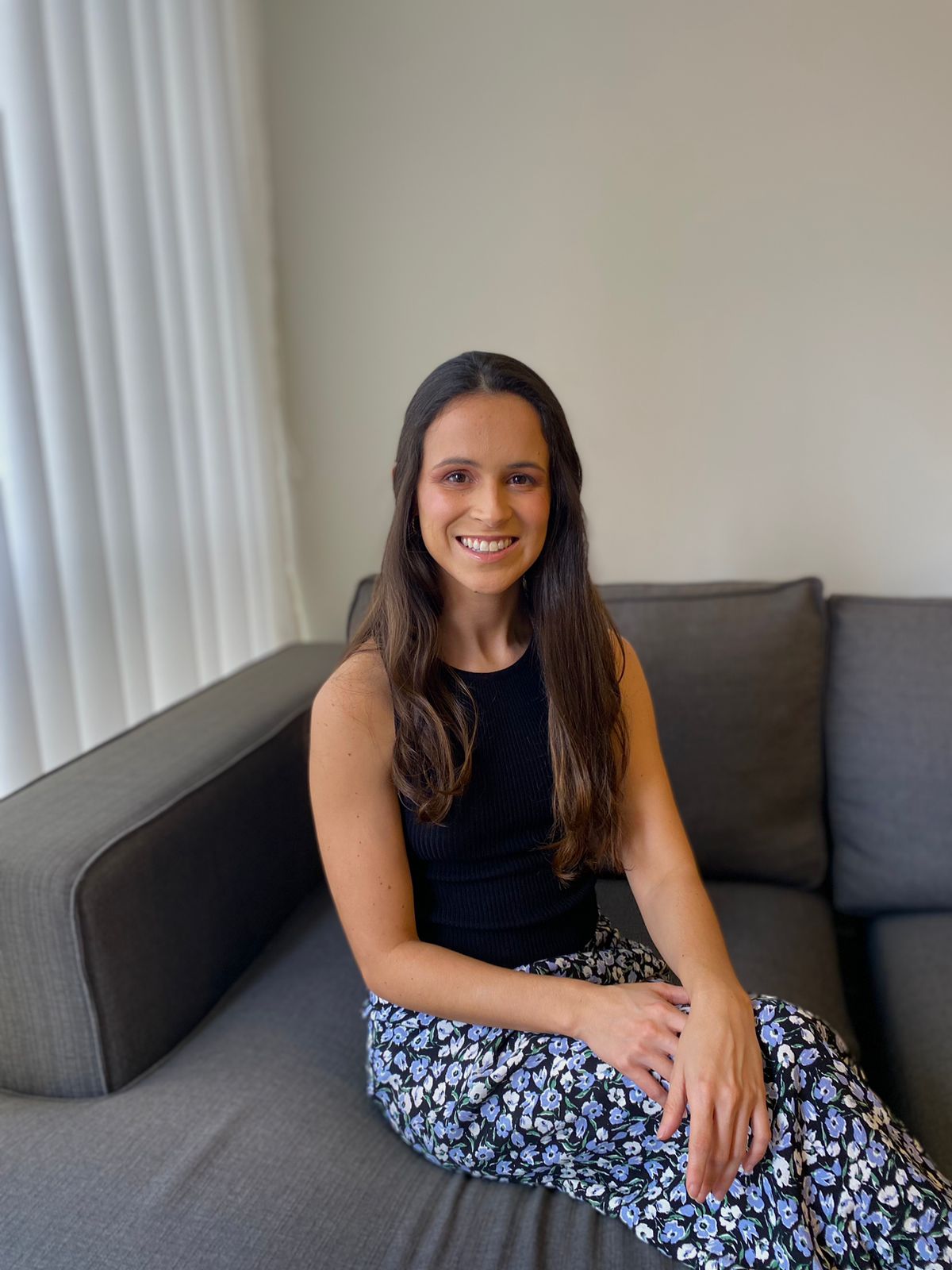Building a Successful Design Team Structure: Best Practices and Insights
The structure of your in-house design team plays a crucial role in maximizing its effectiveness. It determines how your team works with other departments, defines roles and responsibilities, and boosts productivity and growth.
To provide valuable insights, we consulted Louise Nøhr, Head of Operations at 24Slides, who understands the importance of these aspects for your business.

These are the topics we'll go through:
- Starting from the beginning: Exploring in-house design team structures
- Discover the secrets for true success: Gain access to expert insights
- Case study: How we created a successful design team at 24Slides
- FAQs: Get answers to commonly asked questions
So… Let's get started! - Or, as always, you can skip to your preferred section.
How are design teams organized? Understanding in-house design team structures
A design team consists of one or many designers. Depending on the task, these teams share common goals, such as creating a presentation, website, logo, or any design-related project.
The design team's "structure" refers to the various designers' hierarchy and specific responsibilities. The particular structure can vary depending on factors such as the type of business, the number of teams involved, the volume of design work, etc.
What are the 4 structures of a team?
Generally, design team structures can be classified into four main types: centralized, decentralized, flexible, and contractual.
A) Centralized
The centralized option is the most traditional approach for structuring your in-house design team. In this model, the team functions like an internal agency. There is a pyramid hierarchy where the design team reports to a head or creative director responsible for significant decision-making. Each group of designers has a design manager who answers to the head of the design department.
Other departments can send in their requests, and tasks are then allocated to specific teams for handling. It's a great model for creating a unifying design experience!
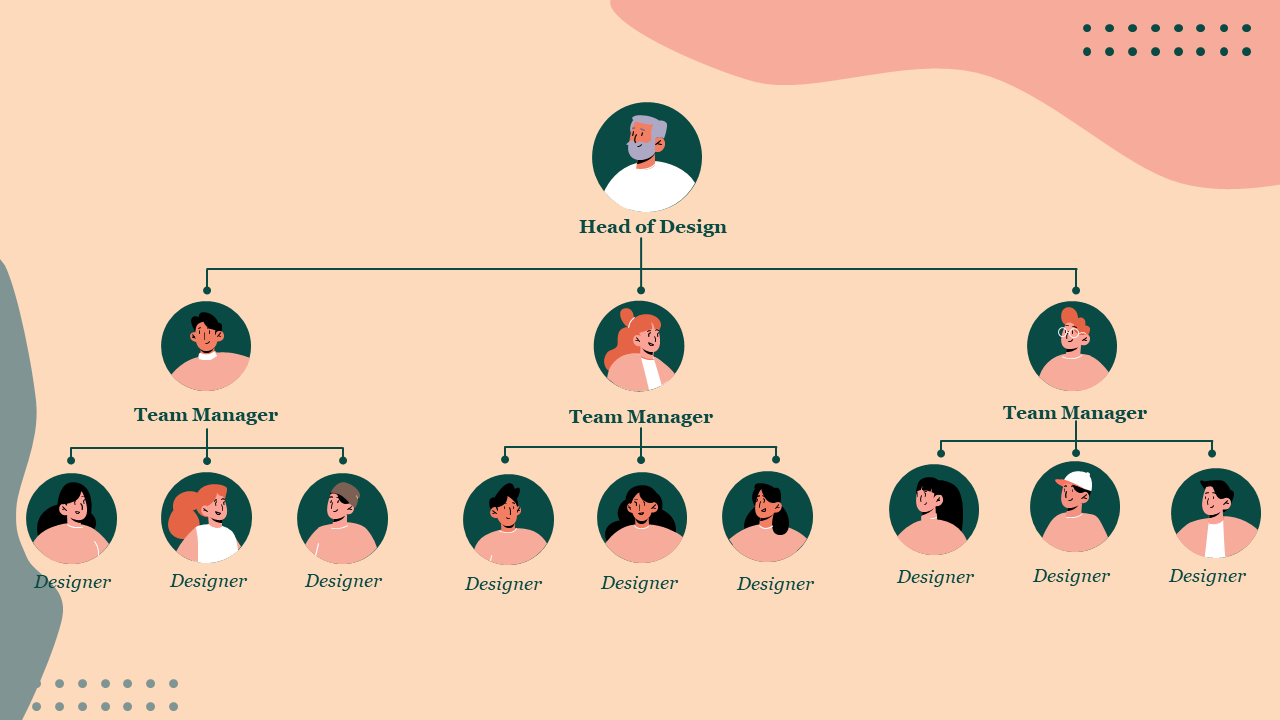
Pros: Great for creating a shared vision and brand unity. Clearly defined roles and hierarchy of responsibilities. Suitable for sharing resources and common goals.
Cons: Longer decision-making process. The design team might be isolated from the other departments.
B) Decentralized
The decentralized structure of an in-house design team is the complete opposite of the centralized model. Also known as embedded, distributed, or cross-functional, this approach does not have a designated head. Instead, designers are integrated into multidisciplinary teams alongside professionals from various departments.
For instance, a project team could consist of a project manager, a designer, a website developer, a salesperson, and a product engineer, all collaborating on a specific project.
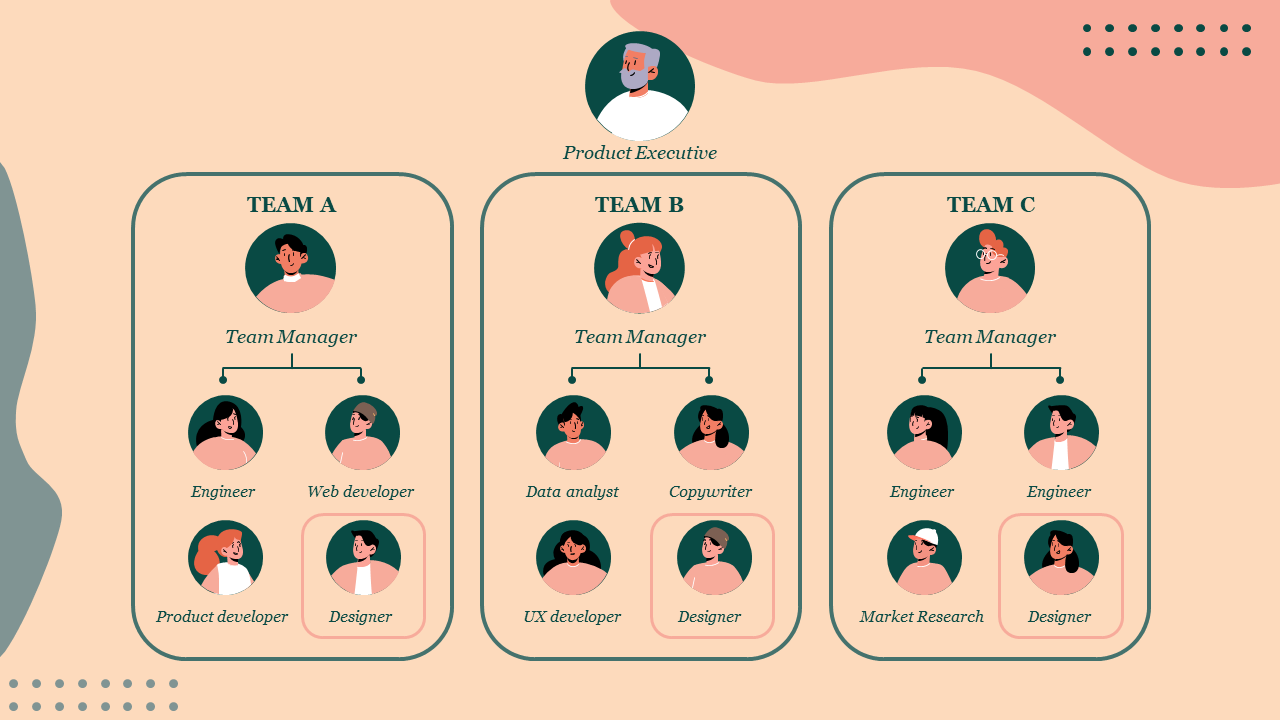
Pros: Faster design process as requests are given directly to the designers. Greater collaboration between different departments.
Cons: Might mean using too much time or resources on repetitive tasks.
C) Flexible
The flexible in-house design structure is like having the best of both worlds! Designers are embedded in multi-departmental teams focused on specific projects and goals.
However, designers also answer to a design director who ensures their vision is aligned with the rest of the teams.
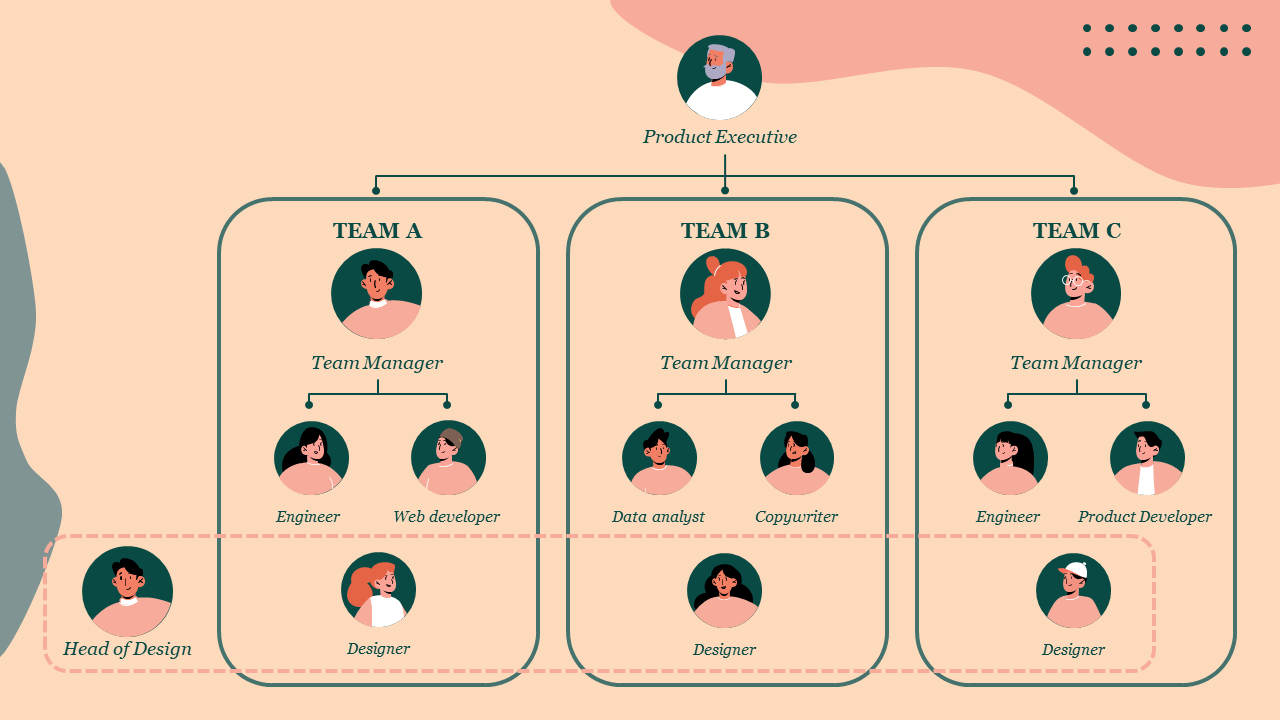
Pros: It’s easily adjustable to the needs of each project and increases focus on goals.
Cons: It can be confusing concerning hierarchy and decision-making.
D) Contractual
Finally, we have the contractual model. This in-house graphic design team structure allows you to have a smaller team that focuses on the most creative, strategic part and hire outside providers for repetitive and routine tasks.
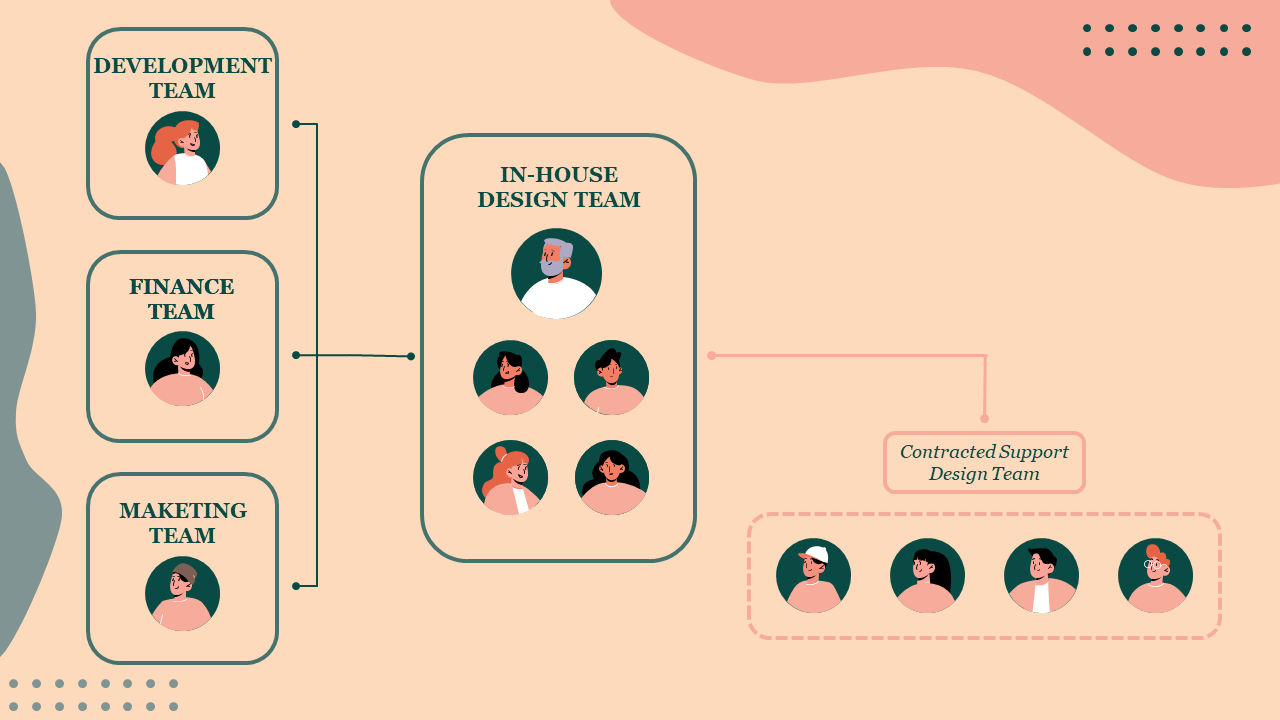
Pros: Cost-efficient, as you only hire the people you need to fill the gaps. It promotes creativity in your in-house design team and lowers their workload, allowing space for them to focus on more relevant tasks.
Cons: Might demand a long research period and a steep learning curve to make it work seamlessly with your in-house team.
Best practices to build a successful design team
Now that you've learned about graphic design team structure, we'll help your team REALLY succeed. So…how do you build a successful design team? Let’s take a look at some insights from our head of operations:
Insight #1: Build for scalability
One of the most important factors to consider is building for scalability. So keep in mind the importance of creating a design team that can adapt to changing needs, not only by scaling up during busy times but also by scaling down.
As Louise shares:
"In-house teams often face challenges when it comes to scaling: Scaling down can result in job losses, and on the other hand, scaling up requires significant investments in recruiting, onboarding, and training. These situations are not uncommon, as we witnessed during the pandemic when organizations had to make tough decisions to resize their teams."
To address this problem, Louise suggests considering outsourcing as a viable option for scalability:
“By outsourcing certain design tasks or projects, we can effectively manage fluctuations in workload while maintaining an in-house team. This approach not only optimizes resource allocation but also minimizes the potential impact on our team members during times of change.”
Is this something that could work for your business? Then, you could consider the contractual model and partially or entirely outsource your design needs. If this is something you are looking for, we invite you to check out the solutions we have for you at 24Slides.
Insight #2: Communication, communication, communication
In the creative design field, effective communication is crucial for successful collaboration among teams. Louise highlights the need to establish a common understanding by focusing on the following:
"It's crucial to have a clear understanding of what exactly the client is looking for and ensure everyone comprehends it the same way. For example: What type of project is it? Are they looking for practicality and precision? Or is it something that allows space for creativity? Not having these aspects clear can be a source of misunderstandings."
How to accomplish this? Follow these tips for effective communication:
- Assign the right people: Make sure there is someone who understands the client's needs and can effectively communicate them to the creative team, keeping everyone on the same page.
- Foster shared ownership: Encourage a collaborative culture where designers are seen as valuable contributors, not just executors. Each team member should take ownership of their work and contribute ideas.
- Share progress: Keep everyone informed by regularly sharing updates and progress. This promotes transparency, allows feedback, and enables timely adjustments.
Insight #3: Establish measurable goals (despite the difficulties)
While quantifying creative work can be challenging, it's essential to strive for measurable goals that demonstrate the impact of design on key performance indicators (KPIs) or user experience.
As Louise emphasizes:
"This also helps you understand how your client perceives your work. Sometimes we think we've created something perfect, but it may not be, or it could be the other way around. Establishing mutual understanding through measurable goals allows us to truly deliver what they are seeking."
Here are some ways to do it:
- Output efficiency: Evaluate how effectively the design team contributes to the organization. For example, you can compare the time or costs saved by hiring the team, as we do at 24Slides:

- User experience feedback: Gather user feedback on the design team's work: surveys, ratings, and qualitative feedback.
- Time of execution: Tracking the team's efficiency in meeting deadlines and delivering high-quality work within expected time frames allows for performance evaluation.
24Slides: Our in-house design team structure
To guarantee our success, we have a carefully structured in-house design team:
We follow a centralized structure, where our head of design ensures that teams perform at their best and work optimally. The team managers are the leaders and answer directly to the head of design.
In addition to the design manager, each team includes designers of various levels, ranging from Senior designers to Junior and Trainee designers, allowing us to create growth and development opportunities.
Each team also has a dedicated Project Manager. This project manager is assigned to each team according to project requirements, making it a flexible team structure. Having them on the team guarantees customer satisfaction and increases communication efficiency between our clients and designers.
This structure is crucial in enabling us to provide the best possible support to other organizations' design teams! It allows us to offer unparalleled fast deadlines and design quality and makes our team easily scalable.
Are you seeking support for your in-house team? 24Slides can definitely help!
Is your in-house team overworked? Are you considering outsourcing? We are here to assist you.
Our specialty is crafting top-notch PowerPoint presentations, and we can also create engaging social media posts, eye-catching infographics, brand logos, icons, and other custom designs upon request.
Does this sound like something that could benefit you? Discover how 24Slides can support your organization and help you maximize your time on more relevant tasks with a dedicated team fully committed to your brand.
FAQ
What is the structure of a design team?
The structure of a design team refers to the organization of different members that work together on design tasks or projects. It provides a framework for establishing clear roles and responsibilities.
Generally, design team structures can be classified into four main types: centralized, decentralized, flexible, and contractual. Selecting the best one for your business requires considering the type and size of your organization and the nature of the company.
If you want to find out which design team organizational structure is the best for your business, we invite you to explore the section where we explain the four different structures.
What are some key design team roles and responsibilities?
When it comes to design, there are key positions that play vital roles in a team:
- Designers: Their main responsibility is to select and arrange elements such as images, colors, symbols, and typography based on the client's specific needs. It's crucial to have a range of experience levels in the team, including senior, junior, and trainee designers.
- Managers: These individuals ensure that the team is moving in the right direction. They create plans for project execution and continuously monitor the team's progress. Managers also ensure continued access to training and growth for the members of the team.
- Head of design: The head of design oversees the whole team. They provide leadership and make decisions to ensure the team's overall success.
- Copywriter/Editor/Proofreader: These professionals are responsible for writing or enhancing existing content that will be incorporated into designs. Their role includes ensuring clarity, error-free writing, and aligning with the client's objectives.
- Customer support: This role involves specialists who directly communicate with clients and effectively convey their requirements to the design team. They act as a bridge between clients and designers, facilitating communication and understanding.
What makes a good design team?
Several factors create a good design team:
- Design quality: This is a top priority. The team's effort's result must align with the customer's expectations.
- Effective time management: This guarantees client satisfaction, project success, and establishing a reputation for reliability. It involves effective and realistic project planning and meeting deliverables on time.
- Good communication: Team members should be able to work together, share ideas, provide constructive feedback, and actively listen to each other.
- Effective leadership: A good leader is vital for a team's success, they are essential in providing support and ensuring everything runs smoothly.
- Flexibility: A good design team can adapt to meet clients' changes and new requirements. They can adjust their timelines, find solutions, and still maintain the quality of their work.
How should the design team be structured?
Are you wondering how you structure an in-house creative team? The best structure for your team depends on many factors, such as the organization's size, project type, and demand volume. Nevertheless, there are some design team structures that are recommended for organizations of different sizes.
- Small organizations: A decentralized model can often be the best option in these cases. This organizational design team structure is excellent for project-oriented teams that work individually and do not require a common shared vision between designers.
- Medium organizations: The centralized team structure works best for medium-sized organizations. It is a good idea when different departments want to delegate their design work. It also works best for teams under one roof, so they can benefit from working as a unit.
- Large organizations: A flexible structure often proves to be the most suitable option for larger organizations. It allows organizations to adapt and allocate their design talent according to project requirements, ensuring optimal results.

